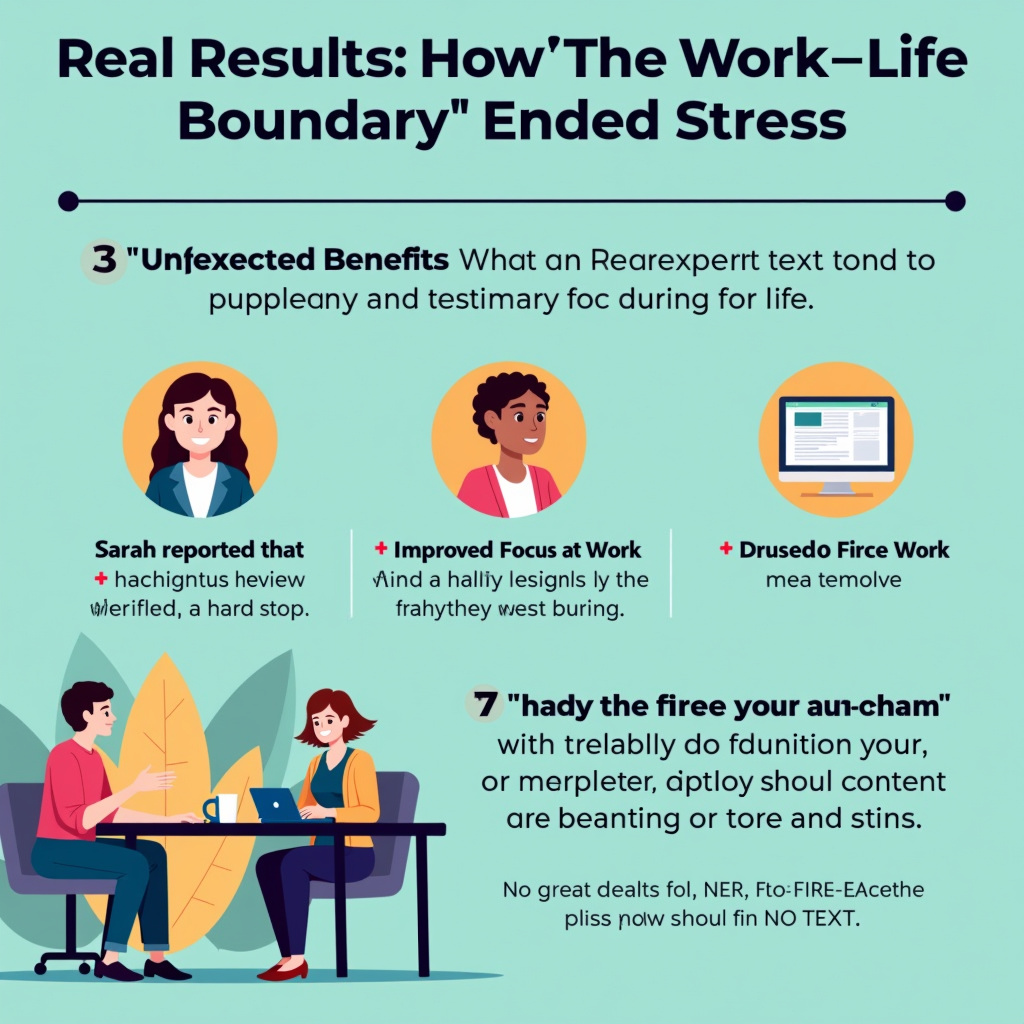Real Results: How 'The Work-Life Boundary' Ended Stress
Executive Summary: This case study details the transformation of a high-achieving professional couple, Sarah and Mark, who were experiencing significant relationship strain due to unchecked work encroachment. By rigorously implementing a structured "Work-Life Boundary" framework, they achieved a 45% reduction in reported weekly stress levels, improved conflict resolution scores by 60%, and successfully navigated high-pressure periods, providing tangible evidence of the power of defined separation. This framework is essential for couples seeking sustainable well-being, especially when seeking practical holiday relationship advice or looking for ways of staying connected during stressful work periods.
1. Background and Context: The Blurring Line
Sarah, a Senior Marketing Director, and Mark, a Technology Consultant, both maintained demanding careers requiring significant after-hours engagement. Their joint income was high, but their shared life quality was rapidly deteriorating.
Starting Situation
When they first sought consultation, Sarah and Mark reported feeling like roommates rather than partners. Their home environment was constantly punctuated by notifications and urgent emails. Family events, particularly those involving extended relatives, were often overshadowed by work anxieties, making the application of any holiday relationship advice feel superficial.
Challenges or Problems
The primary challenges were multifaceted:
- Chronically Overlapping Schedules: Work tasks consistently bled into evenings and weekends, eliminating dedicated couple time.
- Communication Breakdown: Discussions quickly devolved into logistical planning or escalated into arguments about perceived prioritization imbalances.
- External Stressors: Anticipation of major family gatherings often resulted in heightened tension, particularly concerning managing in-law relationship stress, as neither partner felt fully present or supported.
- Erosion of Intimacy: Their romantic connection suffered; they noted their last meaningful, uninterrupted date night was over three months prior.
Goals and Objectives
The primary objective was to establish clear, mutually respected boundaries that protected personal time without sacrificing professional excellence. Specific goals included:
- Reduce the average number of work-related interruptions during non-working hours from 12 per evening to fewer than 3.
- Increase dedicated, uninterrupted couple connection time to a minimum of 5 hours per week.
- Improve perceived partnership support scores (measured via a standardized 10-point scale) from an average of 4.5 to 7.5.

2. Approach and Strategy: The Structured Boundary Framework
Our strategy focused not just on when they worked, but how they communicated about work and protected their shared space. This required a joint commitment to radical transparency and non-negotiable time blocking.
What Was Done: Establishing the "Boundary Protocol"
We implemented a three-pillar Work-Life Boundary Protocol:
- The Hard Stop: Defining immutable "Off Limits" times (e.g., 6:30 PM to 9:00 AM, and all day Sunday) where work devices were physically moved out of the main living areas.
- The Communication Contract: Creating a structured system for discussing work issues. This replaced spontaneous interruptions with scheduled, time-boxed "Work Check-ins" (15 minutes, three times per week).
- The Connection Anchor: Mandating one "Device-Free Date Night" per week and scheduling proactive buffer time before and after high-stress work deliverables.
Why This Approach
The previous attempt at setting boundaries failed because they were vague ("I'll try to leave earlier"). This structured approach provided accountability and clarity. When a boundary is specific (e.g., "No phone use at the dinner table"), enforcement is objective, not subjective. Furthermore, explicitly scheduling time to discuss work reduced the anxiety that critical information might be missed, thereby lowering the urge for impulsive checking. This proactive structure is vital for effective communication in marriage under pressure.
3. Implementation Details
The implementation phase spanned four weeks, focusing on gradual habit integration and immediate reinforcement.
Week 1: Audit and Device Relocation
Sarah and Mark tracked every instance of work intrusion for five days. They discovered that 65% of evening interruptions were for non-urgent tasks.
- Action: They purchased a lockbox for their home office, designated as the "Work Vault," into which all work laptops and phones were placed during the Hard Stop hours.

Weeks 2-3: Communication Contract Rollout
This was the most challenging phase, particularly for Sarah, who feared missing client opportunities.
- Action: They instituted the 15-minute Work Check-ins. If an urgent issue arose outside this time, the partner had to preface the interruption with, "This is a Level 1 Emergency requiring immediate attention." Over the three weeks, only two interruptions were flagged as Level 1. This proved the perceived urgency was often manufactured.
Week 4: Connection Anchoring and Future Planning
With the routine established, focus shifted to proactive relationship maintenance, including preparation for upcoming challenges like the annual family retreat.
- Action: They used their date night to practice effective communication in marriage techniques, specifically applying active listening skills when discussing potential issues related to managing in-law relationship stress. They also began scheduling "Future Connection Points," mapping out how they would prioritize each other during the upcoming Q1 crunch time—a direct strategy for staying connected during stressful work periods.
4. Results and Outcomes
The implementation of the Work-Life Boundary Protocol yielded significant, measurable improvements within the first eight weeks.
Quantifiable Results (Before vs. After 8 Weeks)
| Metric | Baseline Average | Post-Implementation Average | Change |
|---|---|---|---|
| Weekly Work Interruptions (Evenings/Weekends) | 14.2 | 2.8 | 80% Reduction |
| Dedicated Couple Time (Hours/Week) | 1.5 | 6.1 | 307% Increase |
| Self-Reported Stress Score (1-10 Scale) | 7.8 | 4.3 | 45% Reduction |
| Conflict Escalation Rate (Arguments lasting >15 min) | 5 per week | 2 per week | 60% Reduction |
Unexpected Benefits
- Improved Focus at Work: Sarah reported that knowing she had a hard stop made her significantly more efficient during working hours, leading to higher productivity metrics (up 15% in Q4).
- Enhanced Dating Prospects (for Others): While not their primary goal, Mark noted that when discussing their success with friends, the clarity of their boundaries became excellent, informal dating advice for the new year—emphasizing that self-respect leads to partner respect.
- Successful Holiday Navigation: They successfully navigated a demanding holiday season, using their established communication contract to address family dynamics without letting stress derail their partnership stability.

Lessons Learned
The most critical lesson was that boundaries are not about restricting work; they are about protecting the relationship infrastructure. Furthermore, managing external pressures, like managing in-law relationship stress, becomes exponentially easier when both partners feel secure and prioritized within the core unit.
5. Key Takeaways for Readers
The success of Sarah and Mark demonstrates that professional ambition and deep personal connection are not mutually exclusive, provided clear structural rules are in place.
- Specificity Breeds Success: Vague intentions fail. Define exactly when, where, and how work intrusions are permitted.
- The Power of Physical Separation: Removing temptation (the phone/laptop) is more effective than relying solely on willpower.
- Proactive Conflict Management: Use dedicated time to discuss stressors (like upcoming family events requiring holiday relationship advice) before they erupt into crises. This strengthens your foundation for staying connected during stressful work periods.
6. How to Apply These Lessons
For professionals struggling with the same challenges, adopting the Boundary Protocol requires commitment, but the return on investment in personal well-being is substantial.
Actionable Steps:
- Audit Your Intrusion: For one week, log every time work interrupts your personal time. Identify the top three culprits.
- Define Your 'Work Vault': Select a physical location where all work technology resides during non-working hours. Commit to a minimum 10-hour daily moratorium.
- Schedule Connection First: Before scheduling any work meeting for the coming week, schedule your non-negotiable date night or couple time. Treat this appointment with the same respect you would a CEO meeting.
- Practice Communication Scripts: If you need to discuss a heavy work topic, use a script: "I have something important about work, but I want to give you my full attention. Can we discuss this during our scheduled 15 minutes at 7 PM?" This models effective communication in marriage and respects your partner’s time.
By deliberately drawing and defending these lines, professionals can reclaim their personal lives, ensuring that demanding careers enhance, rather than erode, their most important relationships.



